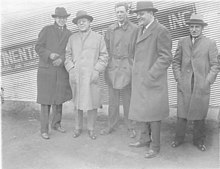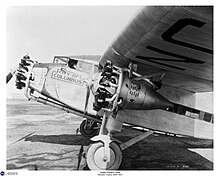
Waynoka is a city in Woods County, Oklahoma, United States. It is located on U.S. Highway 281 and State Highway 14, seventy miles west of Enid. The population, which peaked at 2018 in 1950, stood at 927 according to the 2010 census.

Trans World Airlines (TWA) was a major airline in the United States that operated from 1930 until 2001 when it was acquired by American Airlines. It was formed as Transcontinental & Western Air to operate a route from New York City to Los Angeles via St. Louis, Kansas City, and other stops, with Ford Trimotors. With American, United, and Eastern, it was one of the "Big Four" domestic airlines in the United States formed by the Spoils Conference of 1930.

El Paso International Airport is an international airport located four miles (6 km) northeast of downtown El Paso, in El Paso County, Texas, United States. It is the busiest commercial airport in West Texas, Southern New Mexico and Northern Mexico. It handled 3,667,439 passengers in 2022, with 83,438 cargo operations.

Albuquerque International Sunport, locally known as the Sunport, is the primary international airport serving the U.S. state of New Mexico, particularly the Albuquerque metropolitan area and the larger Albuquerque–Santa Fe–Las Vegas combined statistical area. It handles around 5.4 million passengers annually and over 400 flights daily. ABQ is located in Bernalillo County, between the Rio Grande and the Sandia Mountains, east of Old Town and Barelas, 3 miles (5 km) southeast of downtown, south of the University of New Mexico and directly to the west of Sandia National Laboratories and Kirtland Air Force Base.
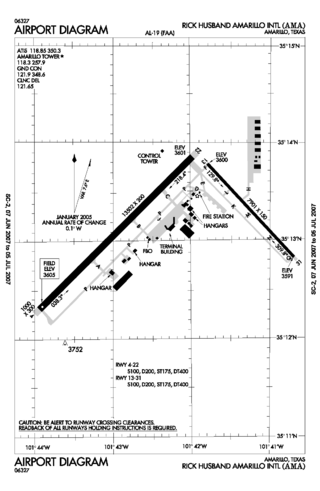
Rick Husband Amarillo International Airport is a public airport six miles (10 km) east of downtown Amarillo, in Potter County, Texas, United States. The airport was renamed in 2003 after NASA astronaut and Amarillo native Rick Husband, who died in the Space Shuttle Columbia disaster in February of that year.
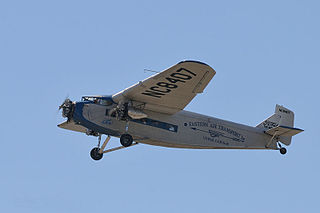
The Ford Trimotor is an American three-engined transport aircraft. Production started in 1925 by the companies of Henry Ford and ended on June 7, 1933, after 199 had been made. It was designed for the civil aviation market, but also saw service with military units.
This is a list of aviation-related events from 1930:
This is a list of aviation-related events from 1929:
Charles B. Wheeler Downtown Airport is a city-owned, public-use airport serving Kansas City, Missouri, United States. Located in Clay County, this facility is included in the National Plan of Integrated Airport Systems, which categorized it as a general aviation reliever airport.
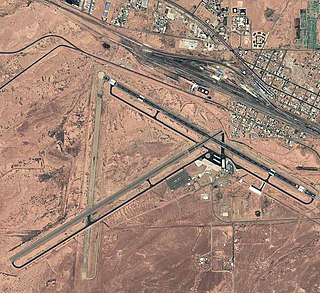
Winslow–Lindbergh Regional Airport is 1 mile mile west of Winslow, in Navajo County, Arizona. The U.S. Forest Service has a firefighting air tanker base here. The airport was served by TWA and Frontier Airlines but now sees no airline service.

West Mesa Airport, also known as Western Air Express Airport, TWA Airport, or Cutter-Carr Airport, was an airport on the West Side of Albuquerque, New Mexico, United States, which was the city's main commercial aviation facility during the 1930s. It was built in 1929 by Western Air Express as a stop on the airline's Los Angeles–Kansas City route, with a hangar and passenger terminal added in 1930. It was the city's second airfield after the original Albuquerque Airport, which was used by a rival airline, Transcontinental Air Transport (TAT). The two airlines merged in 1930 to form TWA, moving all of their operations to the West Mesa field. The merger gave TWA control of the nation's first coast-to-coast passenger airline route and allowed it to secure a lucrative federal airmail contract.

Maddux Air Lines was an airline based in Southern California that operated Ford Tri-motors in California, Arizona, and Mexico in the late 1920s.

On March 31, 1931, a Fokker F-10 belonging to Transcontinental and Western Air crashed near Bazaar, Kansas after taking off from Kansas City Municipal Airport, Kansas City, Missouri.
A transcontinental flight is a non-stop passenger flight from one side of a continent to the other. The term usually refers to flights across the United States, between the East and West Coasts.

The Fokker F-10 was an enlarged development of the Fokker F.VII airliner, built in the late 1920s by the Fokker Aircraft Corporation of America. A trimotor, it carried 12 passengers, four more than the F.VII, and had a larger wing and more powerful engines.

The Keystone K-78 Patrician was an airliner developed in the United States in the late 1920s, built only in prototype form.

Stout Metal Airplane Division of the Ford Motor Company was an American aircraft manufacturer founded by William Bushnell Stout as the Stout Metal Airplane Co. in 1922. The company was purchased by Ford Motor Company in 1924 and later produced the Ford Trimotor. At the height of the Great Depression, Ford closed the aircraft design and production division in 1936, temporarily re-entering the aviation market with the production of the B-24, at the Willow Run aircraft factory during World War II.
Standard Air Lines was an airline founded by Jack Frye, Paul E. Richter and Walter A. Hamilton in 1927. The three had founded Aero Corporation of California in 1926 in Los Angeles and Standard was made a subsidiary of Aero in 1927.

Transcontinental and Western Airways Flight 1 , a Douglas DC-2, crashed into Cheat Mountain, near Uniontown, Pennsylvania, approximately 10:20 a.m. Eastern Standard Time on April 7, 1936, killing 12 of the 14 passengers and crew aboard. Flight 1 was a regularly scheduled TWA Sun Racer flight from Newark, New Jersey, to Los Angeles, California, with almost a dozen intermediate stops between. Approaching the flight's second stop, Pittsburgh, Pennsylvania's Allegheny County Airport, pilot Otto Ferguson lost contact with the airport's radio navigation signal, and tracked several miles in a southwestern line off course. Fearing icing conditions, he descended in an attempt to find visual landmarks for navigation. Thick fog hindered him, and his descent continued until Flight 1 hit ice-covered trees atop Cheat Mountain, about 40 miles (64 km) south of Pittsburgh on the West Virginia line and near Uniontown, Pennsylvania. When the plane crashed it was aiming in a northern flight direction indicating that the pilot finally realized he had tracked south of his flightplan and may have been trying to correct it.

Cannon Air Force Base is a United States Air Force base, located approximately 7 miles (11 km) southwest of Clovis, New Mexico. It is under the jurisdiction of Air Force Special Operations Command (AFSOC). The host unit at Cannon is the 27th Special Operations Wing, which activated on 1 October 2007. The 27 SOW plans and executes specialized and contingency operations using advanced aircraft, tactics and air refueling techniques to infiltrate, exfiltrate and resupply special operations forces (SOF) and provide intelligence, surveillance and reconnaissance and close air support in support of SOF operations.

